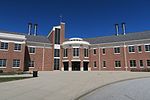Dorrance Inn
Buildings and structures in Windham County, ConnecticutHistoric district contributing properties in ConnecticutHistoric places on the Washington–Rochambeau Revolutionary RouteHotel buildings on the National Register of Historic Places in ConnecticutHotels in Connecticut ... and 4 more
NRHP infobox with nocatNational Register of Historic Places in Windham County, ConnecticutSterling, ConnecticutUse mdy dates from August 2023

The Dorrance Inn, also known as the Samuel Dorrance House, is a historic former inn at 748 Plainfield Pike in Sterling, Connecticut built about 1722. It is notable as a place that hosted officers of the French Army in 1781 and 1782, as it was along the march route taken by French commander Rochambeau's troops on their march to meet the Continental Army under General George Washington. Dorrance's Inn is one of a few places mentioned by name in multiple accounts written by French officers. The building was listed on the National Register of Historic Places in 2002 and is a contributing building in the Sterling Hill Historic District.
Excerpt from the Wikipedia article Dorrance Inn (License: CC BY-SA 3.0, Authors, Images).Dorrance Inn
Sterling Hill Road,
Geographical coordinates (GPS) Address Nearby Places Show on map
Geographical coordinates (GPS)
| Latitude | Longitude |
|---|---|
| N 41.691111111111 ° | E -71.846666666667 ° |
Address
Sterling Hill Baptist Church
Sterling Hill Road
06354
Connecticut, United States
Open on Google Maps









